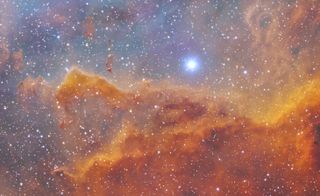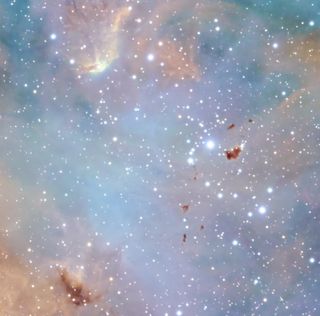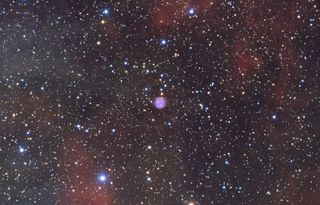
This stunning view of the Running Chicken Nebula, IC 2944, took astrophotographer Rod Prazeres over 42 hours to capture, his longest project yet.
“The Running Chicken Nebula was quite a challenge to image with such a little scope”, Prazeres told Space.com in an email. But Prazeres’ perseverance paid off, with him capturing the stellar nursery in exquisite detail.
“This active stellar nursery, not just a visual spectacle but also a site of complex cosmic phenomena, is easily identifiable by its unique avian shape, which has captured the imagination of astronomers and stargazers alike” Prazeres continued.
Related: Astrophoto of the month: ‘Devil Comet’ delights before leaving our northern sky nights
The Running Chicken Nebula is located in the constellation Centaurus (the Centaur) approximately 6,500 light-years from Earth and and visible only in the Southern Hemisphere.
The vast stellar nursery contains many young stars, all of which emit intense radiation causing the surrounding hydrogen gas to glow in beautiful shades of red. The Running Chicken Nebula is comprised of several regions, each captured in great detail in this image.
“My favourite part of the nebula lies just below λ Centauri, where a nebulous formation presents itself with a mesmerizing blend of colours and shapes,” said Prazeres. “This area, rich in ionized gases and scattered starlight, offers a breathtaking view that highlights the artistic beauty inherent in the cosmos.”

Related stories:
The brightest region of the nebula is called IC 2948. It contains dark clumps of opaque clouds known as Bok globules, named after the Dutch-American astronomer Bart Bok, who drew attention to them in the 1940s. This particular set of Bok globules is known as Thackeray’s Globules, after their discoverer David Thackeray. Bok globules are key targets for studying the early stages of star formation.

While larger Bok globules in calmer conditions can collapse and form new stars, the Thackeray’s Globules imaged here are being bombarded with ultraviolet radiation from nearby stars causing them to erode and fragment. They will be destroyed before they get a chance to collapse and form new stars.
Also captured in this Running Chicken Nebula image is NGC 3766, an open star cluster.

“Known for its tightly packed stars, NGC 3766 provides a stunning contrast to the diffuse nebulosity surrounding it, showcasing the diversity of astronomical objects in this region,” Prazeres said.
In the top left corner of the image is the filamentary shell G296.2-2.8, with faint thread-like structures reaching out across the cosmos.

Prazeres also captured planetary nebula PK294-00.1 with its distinct circular, symmetrical appearance. “It provides a unique visual contrast to the chaotic formations of the surrounding nebulae”, Prazeres continued.

You can find more information about the equipment used and acquisition details in Prazeres’ image entry on AstroBin.
Equipment used:
Camera: ZWO ASI174MM Mini and ZWO ASI2600MM Pro
Telescope: William Optics RedCat 51 II
Mount: Sky-Watcher NEQ6-Pro
Inspired and are thinking about purchasing some new kit? Our guides to the best telescopes and best binoculars are a great place to start. Our best cameras for astrophotography and best lenses for astrophotography, as well as our Astrophotography for beginners guides, will also help you choose the right gear to capture your next stunning space photo.
If you have an astrophoto you’d like to share with Space.com and our readers please send your send your photo(s), comments, and your name and location to spacephotos@space.com.
